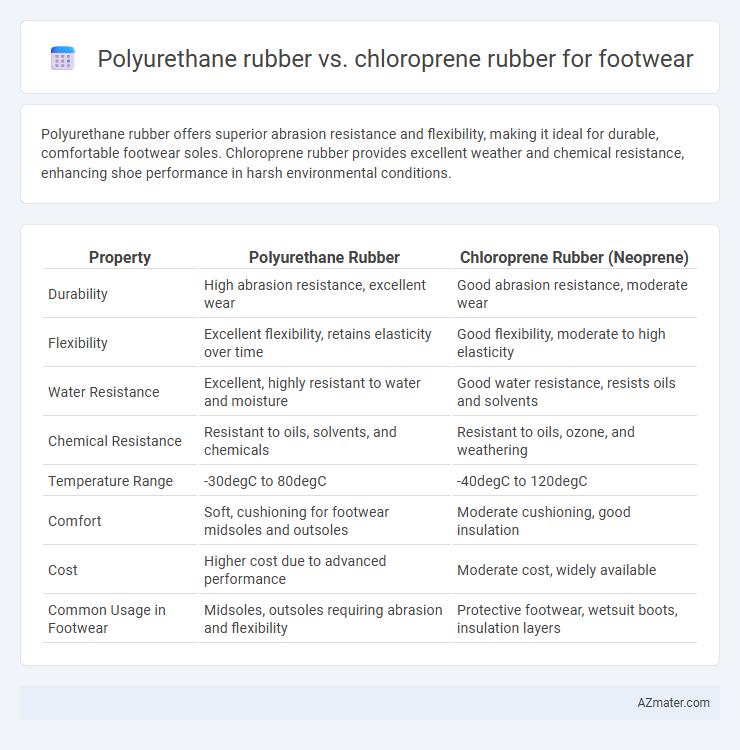Polyurethane rubber offers superior abrasion resistance and flexibility, making it ideal for durable, comfortable footwear soles. Chloroprene rubber provides excellent weather and chemical resistance, enhancing shoe performance in harsh environmental conditions.
Table of Comparison
| Property | Polyurethane Rubber | Chloroprene Rubber (Neoprene) |
|---|---|---|
| Durability | High abrasion resistance, excellent wear | Good abrasion resistance, moderate wear |
| Flexibility | Excellent flexibility, retains elasticity over time | Good flexibility, moderate to high elasticity |
| Water Resistance | Excellent, highly resistant to water and moisture | Good water resistance, resists oils and solvents |
| Chemical Resistance | Resistant to oils, solvents, and chemicals | Resistant to oils, ozone, and weathering |
| Temperature Range | -30degC to 80degC | -40degC to 120degC |
| Comfort | Soft, cushioning for footwear midsoles and outsoles | Moderate cushioning, good insulation |
| Cost | Higher cost due to advanced performance | Moderate cost, widely available |
| Common Usage in Footwear | Midsoles, outsoles requiring abrasion and flexibility | Protective footwear, wetsuit boots, insulation layers |
Introduction to Polyurethane and Chloroprene Rubber
Polyurethane rubber offers exceptional abrasion resistance, flexibility, and lightweight properties, making it ideal for durable and comfortable footwear soles. Chloroprene rubber, also known as neoprene, provides excellent weathering resistance, elasticity, and chemical stability, commonly used in protective and insulated footwear. These polymers differ significantly in performance characteristics, influencing their suitability for various footwear applications.
Key Properties of Polyurethane Rubber
Polyurethane rubber in footwear offers exceptional abrasion resistance, excellent flexibility, and superior tear strength, making it ideal for high-performance and durable shoe soles. Its high elasticity ensures enhanced comfort and shock absorption, while its excellent resistance to oils, chemicals, and weathering extends the lifespan of footwear in diverse environments. Polyurethane rubber also provides lightweight properties without compromising durability, contributing to improved wearability and user experience.
Essential Characteristics of Chloroprene Rubber
Chloroprene rubber (CR) exhibits excellent abrasion resistance, superior elasticity, and strong weathering properties, making it ideal for durable footwear applications. Its inherent oil and chemical resistance enhance the durability of shoes exposed to harsh environments, while good heat and ozone resistance contribute to long-lasting performance. These essential characteristics make chloroprene rubber a preferred material over polyurethane rubber for footwear requiring robust protection and flexibility.
Durability: Polyurethane vs Chloroprene in Footwear
Polyurethane rubber offers superior abrasion resistance and flexibility, making it highly durable for footwear applications subject to frequent wear and tear. Chloroprene rubber provides excellent resistance to weathering, oils, and chemicals, ensuring long-lasting performance in harsh environmental conditions. For footwear durability, polyurethane excels in maintaining structural integrity under mechanical stress, while chloroprene is preferred for enhanced chemical and weather resistance.
Comfort and Cushioning Comparison
Polyurethane rubber offers superior cushioning and durability, making it ideal for footwear requiring long-lasting comfort and shock absorption. Chloroprene rubber provides moderate cushioning with excellent flexibility and water resistance, suitable for footwear used in wet or cold conditions. Polyurethane's dense structure enhances support and comfort over extended wear, while chloroprene excels in flexibility and temperature resilience.
Slip Resistance and Traction Performance
Polyurethane rubber offers superior slip resistance and traction performance in footwear due to its high abrasion resistance and excellent elasticity, providing better grip on wet and oily surfaces. Chloroprene rubber, while durable and resistant to chemicals and weather, generally exhibits moderate traction and may not perform as well as polyurethane on slippery terrains. Choosing polyurethane rubber enhances safety and stability in footwear for demanding environments requiring reliable slip resistance.
Flexibility and Wear Resistance
Polyurethane rubber offers superior flexibility for footwear, adapting easily to foot movements and enhancing comfort during prolonged use. Its wear resistance is exceptionally high, providing durability that withstands abrasive surfaces and reduces the frequency of sole replacement. Chloroprene rubber, while moderately flexible, excels in chemical resistance but generally falls short of polyurethane in sustained wear resistance under heavy mechanical stress.
Water and Chemical Resistance
Polyurethane rubber exhibits superior water resistance and excellent abrasion resistance, making it highly suitable for waterproof footwear applications. Chloroprene rubber offers strong chemical resistance against oils and solvents but is less effective than polyurethane in prolonged water exposure. Footwear made with polyurethane rubber typically performs better in wet and harsh chemical environments due to its enhanced durability and resistance properties.
Typical Footwear Applications for Each Material
Polyurethane rubber is commonly used in athletic shoes and casual footwear due to its excellent abrasion resistance, flexibility, and cushioning properties, enhancing comfort during prolonged wear. Chloroprene rubber, often found in work boots and outdoor footwear, offers superior chemical resistance, weatherability, and durability, making it ideal for harsh environmental conditions. Each material's unique properties cater to specific footwear demands, with polyurethane favoring lightweight flexibility and chloroprene excelling in rugged protection.
Choosing the Right Rubber for Footwear Manufacturing
Polyurethane rubber offers superior abrasion resistance and flexibility, making it ideal for durable and comfortable footwear soles, while chloroprene rubber provides excellent weather and chemical resistance, suitable for outdoor and industrial shoes. Selecting polyurethane enhances cushioning and wear life in casual and athletic shoes, whereas chloroprene is preferred for footwear requiring waterproofing and oil resistance. Manufacturers must weigh factors like performance requirements, cost efficiency, and target use environments to determine the optimal rubber type for footwear production.

Infographic: Polyurethane rubber vs Chloroprene rubber for Footwear
 azmater.com
azmater.com